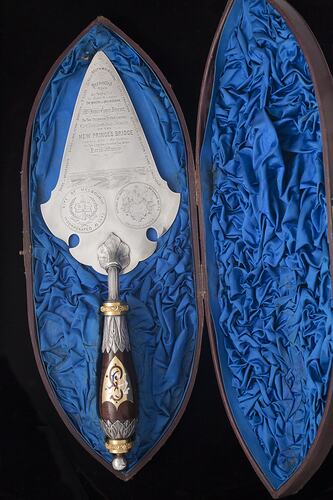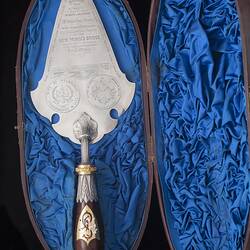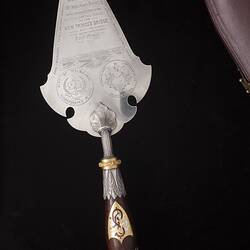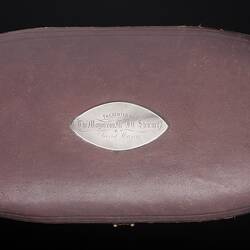Summary
Presentation trowel created for the public ceremony marking the laying of the foundation stone for Princes Bridge in 1886. Presented to the wife of the Mayor of Melbourne, Mrs James Cooper Stewart on 7th September 1886, by the contractor for work David Munro.
The bridge itself, spanning the Yarra River between Swanston Street and St Kilda Road, is a significant piece of Melbourne's infrastructure, indeed a Melbourne icon. The trowel is considered a marvellous example of engraving and jewellery.
For over a centenary, Princes Bridge crossing the Yarra River between Swanston Street and St Kilda Road has been one of Melbourne's most recognisable and enduring landmarks and a key part of the city's transport infrastructure. Originally designed by architect and engineer, John Harry Grainger (1855-1917) - father of the composer George Percy Grainger - in 1879, as the winning entry for a design competition, Princes Bridge was built by David Munro & Co, for the Public Works Department in 1886-88. It replaced an earlier stone arch bridge completed in 1850, and is close to the site of the first timber bridge built across the Yarra River in 1844. By the 1880s a new bridge was required both to allow for the widening of the Yarra for flood mitigation and improved shipping access to the river wharves and to allow for the additional loading created by cable trams. The 400 feet (120 metres) long by 99 feet (30 metres) wide bridge is of a unique design for Victoria with three riveted iron girder arch spans on bluestone abutments and piers and has distinctive cast-iron spandrel panels and ornate lamp stands featuring the coat of arms of the State of Victoria and the Cities of Melbourne, South Melbourne, Prahran, St Kilda, Brighton, Caulfield and Moorabbin, who jointly funded the construction.
Physical Description
Decorative presentation metal trowel with wooden handle in custom leather case, lined with blue satin. Trowel blade is engraved with extensive text and includes a finely engraved image of the Prince's Bridge. Handle is embellished with gold and silver decorative bands and a golden shield.
Significance
Princes Bridge is of engineering and architectural significance for its substantial size and for the skilled stonemasonry demonstrated in the construction of the abutments and piers. It is also of historical significance because of the key transport link that it has provided for over 130 years between the city of Melbourne propoer, and its southern suburbs. The bridge also has asthestic significance as a key landmark symbolic of hte city of Melbourne and has appeared in countless images over the decades showing the view from the southern bank of the Yarra River showing the bridge spanning the foreground and the city skyline beyond.
This engraved trowel made for use in the public ceremony to mark the laying of the foundation stone for the bridge in 1886, provides a tangible reminder of the large public works projects undertaken to transform the City of Melbourne in the last two decades of the 19th century. As with all major infrastructure projects, bridge construction has typically been an area where other than the built form itself or images of the structure, it is difficult to find tangible artefacts that tell a story directly about the construction and commissioning of the infrastructure. This trowel provides links to both one of Melbourne's most famous bridges and one of the city key early engineers.
More Information
-
Collecting Areas
-
Acquisition Information
Purchase
-
Presented To
Mrs Mary Stewart, Princes Bridge, St Kilda Road, Melbourne, Greater Melbourne, Victoria, Australia, 7 Sep 1886
-
Presented By
David Munro, Princes Bridge, St Kilda Road, Melbourne, Greater Melbourne, Victoria, Australia, 7 Sep 1886
-
Manufacturer
H. Newman, 123 Elizabeth Street, Melbourne, Greater Melbourne, Victoria, Australia, 1886
Name appears on the base of the case. Henry Newman was born Riga, Russia (later Latvia) in 1824, and arrived in Victoria in 1852, establishing himself as a watchmaker and jeweller in Melbourne shortly afterwards. His firm, later known as H. Newman & Sons, sold imported watches and jewellery as well as locally manufactured works in gold and silver, and remained one of Melbourne's most prominent businesses in the field through the late 19th and early 20th centuries. -
Manufacturer of Component
Fielder & Co, 8 Franklin Street W, Melbourne, Greater Melbourne, Victoria, Australia, circa 1886
The name 'Fielder & Co / 8 Franklin Street W' also appears on the underside of the case and was probably the manufacturer or supplier of the case. -
Inscriptions
Engraved on blade of trowel: "Presented to the WIFE / of the Right Worshipped / THE MAYOR OF MELBOURNE / Mrs James Cooper Stewart / ON THE OCCASION OF HER LAYING / THE FOUNDATION STONE / OF THE / NEW PRINCE'S BRIDGE / 7th September 1886 Her Birthday /BY THE CONTRACTOR FOR WORK / David Munro" Engraved as a border around the blade of the trowel: "SHIRE OF MOORABBIN / SHIRE OF MALVERN / BOROUGH OF ST KILDA / CITY OF SOUTH MELBOURNE / CITY OF PRAHRAN / BOROUGH OF BRIGHTON / SHIRE OF CAUFIELD" Engraved beneath presentation text: "CITY OF MELBOURNE INCORPORATED AD 1842" and "VICTORIA DEI GRATIA / BRITTANIAR REG F.D. / COLONY OF VICTORIA". Engraved on silver plate on lid of case: "PRESENTED TO / The Mayoress Mrs J. C. Stewart / BY / David Munro". Marked on label on underside of case: "H. Newman / Watchmakers and Jewellers / 123 Elizabeth Street" also "Fielder & Co / 8 Franklin Street W".
-
Classification
-
Category
-
Discipline
-
Type of item
-
Object Measurements
385 mm (Length), 130 mm (Width), 30 mm (Height)
-
Box Dimensions
440 mm (Width), 175 mm (Depth), 56 mm (Height)
-
Keywords



